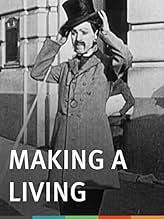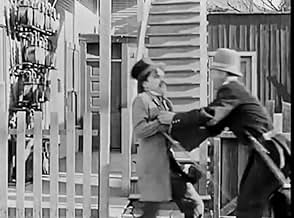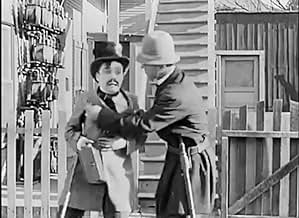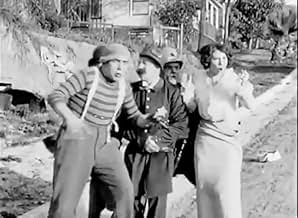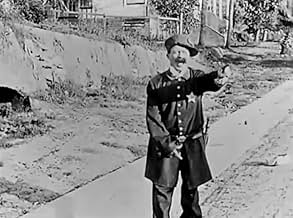Agrega una trama en tu idiomaAn out-of-work swindler takes a job as a reporter. After witnessing a car go over cliff, he grabs a rival reporter's camera and races to the newspaper office to enter the photo as his own. H... Leer todoAn out-of-work swindler takes a job as a reporter. After witnessing a car go over cliff, he grabs a rival reporter's camera and races to the newspaper office to enter the photo as his own. His rival is delayed when he gets caught in a woman's bedroom by her jealous husband. The s... Leer todoAn out-of-work swindler takes a job as a reporter. After witnessing a car go over cliff, he grabs a rival reporter's camera and races to the newspaper office to enter the photo as his own. His rival is delayed when he gets caught in a woman's bedroom by her jealous husband. The swindler follows the distribution of the paper containing his 'scoop' around town where he ... Leer todo
- Tough guy
- (sin créditos)
- Jealous Husband's Wife
- (sin créditos)
- Policeman
- (sin créditos)
- …
- Mother
- (sin créditos)
- Girl
- (sin créditos)
- Jealous Husband
- (sin créditos)
- Seated Man with Editor
- (sin créditos)
- Newspaper Editor
- (sin créditos)
- Wreck Bystander
- (sin créditos)
- Daughter
- (sin créditos)
- Cops
- (sin créditos)
- Reporter
- (sin créditos)
- Bald Man in Newspaper Office
- (sin créditos)
- Cop at Apartment Steps
- (sin créditos)
- Onlooker
- (sin créditos)
- Dirección
- Guionista
- Todo el elenco y el equipo
- Producción, taquilla y más en IMDbPro
Opiniones destacadas
As a comedy, it fails to elicit a single chuckle. And the only interesting bit of filmmaking comes at the very end when we see Chaplin and another actor jumping onto the front of a moving streetcar. The plot thickens no further!
Cinema buffs and Chaplin fans will find this film of interest as the debut of one of cinema's finest talents, but casual fans, and particularly fans of the Little Tramp, are better served skipping this one and watching Chaplin's second effort, Kid Races at Venice (1914), which is a far more successful comedy and features the Tramp's debut.
The first thing we notice is that the familiar costume hasn't been developed yet. In the very first shot, when Chaplin approaches his co-star (and director) Henry Lehrman to ask for a hand-out, it takes us a moment to adjust to his exotic appearance: he wears a top hat, tan frock coat, and droopy mustache. He looks a bit seedy but he's not exactly a tramp, more like an eccentric gent who is down on his luck. It's interesting to observe Chaplin in this extended opening sequence as he puts the touch on a man who is, apparently, a total stranger. He engages Lehrman in light conversation, examines the man's ring, briefly pretends to steal it, chuckles winningly, and then gets down to the business of genteel pan-handling. At first Lehrman refuses him a loan, but when he relents and offers cash Chaplin suddenly turns him down -- and then, as the offer is withdrawn, quickly grabs it. It's a nice little scene, more relaxed and nuanced than what we might expect.
All that follows is more conventional, as it details the escalating (and increasingly violent) rivalry between Chaplin and Lehrman, first over the same girl and then over the same job, at a newspaper office. Along the way we recognize some Chaplin expressions and mannerisms familiar from later performances, but we also note that Charlie's character is decidedly unsympathetic: he's a con man who repeatedly double-crosses his reluctant benefactor, Lehrman. At one point during a battle Chaplin holds Lehrman at bay with his walking stick, as he later would with Eric Campbell in The Rink (1916), but The Little Tramp seems worlds away. Eventually, when Lehrman manages to take some photos at the scene of a car accident, Charlie steals his camera and attempts to pass off the photos as his own. What a scoundrel!
For a newcomer to movie-making Chaplin appears perfectly relaxed before the camera. Despite all the scuffling and running around that takes place here, both Chaplin and Lehrman (who doesn't display much screen presence) give performances that are noticeably more restrained than the Keystone norm of the time. Towards the end, when Chester Conklin appears as a cop, his grotesque makeup and out-sized reactions look quite exaggerated in contrast to the two leads. It's also interesting to observe that Chaplin and Lehrman, who quickly developed an intense mutual antipathy off-camera, spend most of their on-screen time together as adversaries, both in this film and in Kids' Auto Race, made soon afterward. It seems that Chaplin was signaling, from the very outset, that he would not passively submit to direction from others -- or at least not from Henry Lehrman. And it wouldn't be long after this, just a few months, before Chaplin would be directing his own work, and his brilliant career would be launched in earnest.
It looks very much as if the film has deteriorated quite a bit physically, which makes it somewhat difficult to tell how good it may have been originally. Not that it would have been anything exceptional anyway, but some of the frantic action would probably be easier to follow if the print were in better shape, without anything missing.
Here, Charlie plays a character who is continually looking for ways to outwit a rival as he tries to make good. He gives the role plenty of energy, as you would expect, and he does as much as anyone could have within the limitations of the story line. In itself, it's nothing special, but to anyone who enjoys silent films, it's well worth watching just to see what the start of Chaplin's career was like.
This is a Keystone short, so there is quite a bit of slapstick humor. Perhaps it's due to this movie being over 90 years old when I saw this, but I could not tell what exactly happened between Chaplin and the reporter (played by director Henry Lehrman). There are a few interesting parts.
If you are a fan of Chaplin and can't get enough of his work or a fan of silent slapstick comedies, this might be worth a look. Then again, it's only about 8 or 9 minutes long, so if you don't like it, you haven't wasted much of your time.
¿Sabías que…?
- TriviaFilm debut of Charles Chaplin. NOTE: One of the few films in those early years in which he does not play the Tramp.
- ConexionesFeatured in Hollywood and the Stars: The Funny Men: Part 1 (1963)
Selecciones populares
Detalles
- Fecha de lanzamiento
- País de origen
- Sitios oficiales
- Idiomas
- También se conoce como
- Take My Picture
- Productora
- Ver más créditos de la compañía en IMDbPro
- Tiempo de ejecución
- 11min
- Color
- Mezcla de sonido
- Relación de aspecto
- 1.33 : 1

